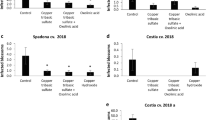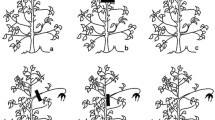Abstract
The pear production area in Israel is 1500 ha, most of which(ca 1200 ha) is located in the northern part of the country. Fire blight (caused by the bacteriumErwinia amylovora (Burrill) Winslowet al.) was first observed in Israel in that region (in 1985) and the disease has prevailed there since then. In a comprehensive survey conducted in Israel in 1996–1999, data were collected and observations were made yearly in one-third to one-half of the pear production area. The aim was to document the prevalence and intensity of fire blight in commercial orchards and to use the data to evaluate the efficacy of management measures employed for its suppression. Regionwise, a severe fire blight epidemic developed in 1996, moderate epidemics developed in 1998 and 1999, and a mild epidemic developed in 1997. The intensity of fire blight in the preceding season in a specific orchard was more influential on current season severity in a season with a mild epidemic than in a season with a moderate epidemic. Analysis of disease onset records and weather data revealed that only a few (1– 3) infection episodes occurred in individual orchards each year. Comparison of fire blight intensity in orchard-plots treated before green tip with copper hydroxide with nontreated plots revealed that the treatment had no effect on disease intensity during bloom. The efficacy of bactericide sprays applied during bloom was not related to the number of sprays applied but to the timing of spraying. Adequate control was achieved in orchard-plots sprayed soon before or after the occurrence of infection episodes.
Similar content being viewed by others
References
Billing, E. (1980) Fire blight (Erwinia amylovora) and weather: a comparison of warning systems.Ann. Appl. Bio). 95:365–377.
Deckers, T., Daemen, E. and Hayen, I. (1996) Fire blight control under temperate zone climatology.Acta Hortic. 411:417–427.
Johnson, K.B. and Stockwell, V.D. (1998) Management of fire blight: a case study of microbial ecology.Annu. Rev. Phytopathol. 36:227–248.
Manulis, S., Kleitman, F., Dror, O., David, I. and Zutra, D. (1998) Characterization of theErwinia amylovora population in Israel.Phytoparasitica 26:39–46.
Manulis, S., Zutra, D., Kleitman, F, Dror, O., David, I., Zilberstaine, M. and Shabi, E. (1998) Distribution of streptomycin-resistant strains ofErwinia amylovora in Israel and occurrence of blossom blight in the autumn.Phytoparasitica 26:223–230.
Mills, W.D. (1955) Fire blight development on apple in western New York.Plant Dis. Rep. 39:206–207.
Schroth, M.N., Thompson, S.V., Hildebrand, D.C. and Moller, W.J. (1974) Epidemiology and control of fire blight.Annu. Rev. Phytopathol. 12:389–412.
Shabi, E. and Zutra, D. (1987) Outbreaks of fire blight in Israel in 1985 and 1986.Acta Hortic. 217:23–30.
Smith, T.J. (1993) A predictive model for forecasting fire blight of pear and apple in Washington State.Acta Hortic. 338:153–160.
Steiner P.W. (1990) Predicting apple blossom infections byErwinia amylovora using the MARYBLYT model.Acta Hortic. 273:149–158.
Shtienberg, D., Kritzman, G., Herzog, Z., Oppenheim, D., Zilberstaine, M. and Blatchinsky, D. (1999) Development and evaluation of a decision support system for management of fire blight in pears.Acta Hortic. 489:385–392.
Tsiantos, J. and Psallidas, P. (1993) Experiments on chemical control of fire blight(Erwinia amylovora) in Greece.Phytopathol. Mediterr. 32:201–205.
Van der Zwet, T. (1996) Present world-wide distribution of fire blight.Acta Hortic. 411:7–8.
Van der Zwet, T. and Beer, S.V. (1995) Fire Blight — Its Nature, Prevention, and Control.U.S. Dep. Agric. Bull. No. 631.
Zutra, D., Shabi, E. and Lazarovits, G. (1986) Fire blight on pear, anew disease in Israel.Plant Dis. 70:1071- 1073.
Author information
Authors and Affiliations
Corresponding author
Additional information
Contribution no. 508/00 from the Inst. of Plant Protection, ARO, Bet Dagan, Israel.
Rights and permissions
About this article
Cite this article
Shtienberg, D., Oppenheim, D., Herzog, Z. et al. Fire blight of pears in Israel: infection, prevalence, intensity and efficacy of management actions. Phytoparasitica 28, 361–374 (2000). https://doi.org/10.1007/BF02981831
Received:
Revised:
Issue Date:
DOI: https://doi.org/10.1007/BF02981831




